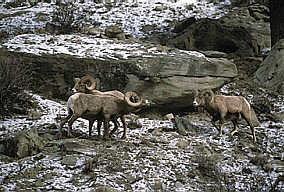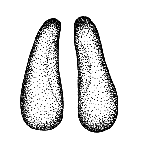
Bighorn Mountain Sheep
Ovis canadensis
or California Bighorn Sheep, Rocky Mountain Bighorn
Sheep
Description
- The Bighorn Mountian Sheep's muscular bodied animal
is covered with a brown coat, the belly, rump, back
of legs, muzzle and eye patch are white. The most distinct
feature of the mature male Bighorn is a set of massive
horns which spiral backwards from the top of the head.
The hooves are hard on the outside and soft on the inside
making it an excellent climber and jumper.
Distribution
- The California Bighorn resides in alpine meadows and
foothills near rocky cliffs in the Okanagan, Similkameen
and south Chilcotin regions. Most sheep ranges are within
easy range of cliffs with avalanche chutes and talus
slopes which they use to escape from predators.
Biology
- This sheep tends to be a grazing animal and feeds
on grasses such as wheatgrass, bluegrass and Junegrass.
The rutting season is for Bighorn Mountain Sheep is
from mid-September to lats October. During this time
the males have butting contests where they may reach
one another at speeds of 50-70 miles per hour and an
estimated force of 2400 pounds. The maximum life span
is 16-18 years but and average is about 7-8 years. Most
die during the winter from cold, predation or disease
due to malnutrition. The Bighorn has always been prized
for their meat; the horns were used by some Indians
to make powerful bows and are still prized by hunters
as trophies.

Tracks - The track of the Bighorn Sheep has a
straighter edge and is less pointed than that of the
deer with a blockier shape and small hollow on the inside
of the hoof. Regardless of these differences, the tracks
of the deer and Bighorn Sheep are easily confused.
Straddle: 17 - 20 cm (6.8 - 8 in)
Stride: 45 - 58 cm (18 - 23.2 in)
Track: 7.5 cm (3 in) long / 5 cm (2 in) wide


